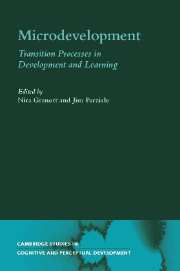Book contents
- Frontmatter
- Contents
- List of figures
- List of tables
- List of contributors
- Microdevelopment: A process-oriented perspective for studying development and learning
- Part I Variability
- Part II Transition mechanisms
- Part III Micro- and macrodevelopment
- 7 Interacting time scales in personality (and cognitive) development: Intentions, emotions, and emergent forms
- 8 How microdevelopment creates macrodevelopment: Reiterated sequences, backward transitions, and the Zone of Current Development
- 9 Macro- and microdevelopmental research: Assumptions, research strategies, constraints, and utilities
- Part IV Context
- Author index
- Subject index
- References
7 - Interacting time scales in personality (and cognitive) development: Intentions, emotions, and emergent forms
Published online by Cambridge University Press: 22 September 2009
- Frontmatter
- Contents
- List of figures
- List of tables
- List of contributors
- Microdevelopment: A process-oriented perspective for studying development and learning
- Part I Variability
- Part II Transition mechanisms
- Part III Micro- and macrodevelopment
- 7 Interacting time scales in personality (and cognitive) development: Intentions, emotions, and emergent forms
- 8 How microdevelopment creates macrodevelopment: Reiterated sequences, backward transitions, and the Zone of Current Development
- 9 Macro- and microdevelopmental research: Assumptions, research strategies, constraints, and utilities
- Part IV Context
- Author index
- Subject index
- References
Summary
The relations between time scales of development, particularly microdevelopment and macrodevelopment, remain largely unexplored, both theoretically and empirically. How do processes in real time affect the laying down of shape and structure over developmental time? How do momentary events create novel forms or patterns that last for years or even a lifetime? The opposite causal direction is just as mysterious. How do longstanding patterns, only visible on a developmental scale, influence activity in real time, and very often in a way that serves to further entrench those patterns? Like the activity of a sculptor, small movements create lasting form that directs subsequent movements, as the sculptor comes to recognize the shape to which the medium gives rise. Yet there is no sculptor. Development may better resemble M. C. Escher's famous lithograph of two hands drawing each other: the form creates itself.
One of the most serious conundrums for cognitive developmentalists has been the integration of time scales of learning and development. When learning and development are simply viewed as different amounts of the same thing, theorists fail to look for the transformations through which they are related (Lerner, 1995). Conversely, when they are considered incommensurable, theorists tend to dismiss one and concentrate on the other rather than recognize their intrinsic complementarity (Granott, 1998). When learning and development are viewed as distinct yet complementary, their relationship is often assumed to be unidimensional and context-free, a perspective that obscures the multiple, nonlinear pathways that connect them (Fischer & Granott, 1995).
Information
- Type
- Chapter
- Information
- MicrodevelopmentTransition Processes in Development and Learning, pp. 183 - 212Publisher: Cambridge University PressPrint publication year: 2002
References
Accessibility standard: Unknown
Why this information is here
This section outlines the accessibility features of this content - including support for screen readers, full keyboard navigation and high-contrast display options. This may not be relevant for you.Accessibility Information
- 31
- Cited by
